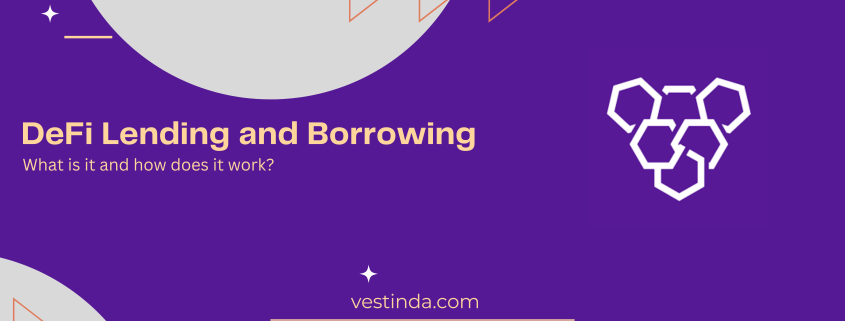DeFi, or Decentralized Finance, has revolutionized traditional lending and borrowing systems by operating on blockchain technology without intermediaries. DeFi lending and borrowing involve users lending their cryptocurrencies to others in exchange for interest, or borrowing assets by collateralizing their own crypto holdings. Smart contracts facilitate these transactions, ensuring transparency, security, and automation of the lending process. This peer-to-peer system enables global access to financial services, allowing anyone with an internet connection to borrow or lend funds without relying on centralized institutions. Explore this comprehensive guide to delve into the mechanics, benefits, risks, and future prospects of DeFi lending and borrowing.
Article summary
What is DeFi Lending nd Borrowing?
DeFi lending and borrowing represent a decentralized financial system operating on blockchain technology, enabling users to lend or borrow digital assets without intermediaries like banks. In this ecosystem, individuals can either lend their cryptocurrencies to others and earn interest or borrow assets by collateralizing their own crypto holdings.
Smart contracts, self-executing code deployed on the blockchain, govern these transactions, automating lending terms and ensuring security and transparency. Borrowers provide collateral, usually in excess of the borrowed amount, determining their borrowing capacity. Interest rates fluctuate based on platform demand and supply dynamics. This peer-to-peer lending model allows global access to financial services, offering inclusivity, transparency, and the potential for higher yields compared to traditional lending systems.
How does DeFi Lending and Borrowing work?
DeFi lending and borrowing operate through decentralized platforms, utilizing smart contracts to enable users to lend or borrow digital assets without intermediaries. Here’s a breakdown of how this revolutionary system works:
- Collateralization: Borrowers can obtain loans by collateralizing their cryptocurrencies. They lock up a certain amount of their digital assets into a smart contract as collateral, which is usually overcollateralized to mitigate the risk of default. The collateral value determines the borrowing limit and helps maintain the security of the loan.
- Loan Issuance: Once collateral is provided, borrowers can receive loans in various cryptocurrencies or stablecoins. The terms, including interest rates and repayment schedules, are predefined by the smart contract code, ensuring transparency and immutability of the agreement.
- Interest Rates: Interest rates in DeFi lending and borrowing are determined by the supply and demand dynamics of the platform. Lenders earn interest on the assets they supply, while borrowers pay interest on the funds they borrow. These rates can fluctuate based on market conditions and the utilization of assets within the platform.
- Liquidity Provision: Users who supply assets to the lending pools earn passive income through interest generated by borrowers. This process incentivizes users to contribute to the liquidity of the platform, ensuring a continuous flow of funds available for borrowing.
- Risk Management: Smart contracts in DeFi platforms have built-in liquidation mechanisms. If a borrower’s collateral value falls below a certain threshold due to market volatility or price fluctuations, the smart contract may liquidate the collateral to cover the outstanding loan and protect lenders from losses.
DeFi lending and borrowing, operating in a trustless and transparent environment, provide users with access to financial services while eliminating the need for intermediaries. However, users must remain vigilant about the risks associated with smart contract vulnerabilities, market fluctuations, and the potential for liquidations in volatile conditions.
What is the difference between DeFi lending and traditional lending?
DeFi lending and traditional lending represent two distinct paradigms in the world of finance, differing significantly in their underlying principles, operational mechanisms, and the entities involved.
- Centralization vs. Decentralization: Traditional lending typically involves centralized financial institutions like banks or credit unions that act as intermediaries between lenders and borrowers. These institutions oversee the lending process, set interest rates, and manage borrowers’ credit evaluations. In contrast, DeFi lending operates on decentralized platforms running on blockchain technology, eliminating intermediaries. Smart contracts facilitate lending and borrowing directly between users without the need for a trusted third party.
- Access and Inclusivity: Traditional lending often requires a comprehensive credit history, collateral, and geographical proximity to financial institutions, limiting access for many individuals, particularly those in underserved or remote areas. DeFi lending, on the other hand, is more inclusive and accessible. It allows anyone with an internet connection to participate, irrespective of location or credit history, provided they have digital assets for collateral.
- Transparency and Automation: DeFi lending platforms operate transparently on the blockchain, with all transactions recorded publicly. Smart contracts execute lending terms automatically, ensuring transparency, immutability, and eliminating human intervention in the lending process. In contrast, traditional lending involves opaque processes where borrowers may have limited visibility into how their creditworthiness is evaluated, and loan terms are subject to the discretion of financial institutions.
- Risk and Security: Traditional lending relies on regulatory oversight and institutional policies to manage risks and ensure security. DeFi lending, while offering greater accessibility, also poses risks due to potential vulnerabilities in smart contracts, market volatility affecting collateral values, and the absence of regulatory safeguards prevalent in traditional finance.
Understanding these differences is crucial for investors and borrowers seeking financial opportunities. While traditional lending offers stability and regulation, DeFi lending offers accessibility and innovation but comes with its own set of risks that participants must carefully consider.
How to borrow money from DeFi
Borrowing money from DeFi (Decentralized Finance) platforms involves several steps and precautions to ensure a smooth and secure process:
- Selecting a DeFi Platform: Choose a reputable DeFi lending platform that suits your borrowing needs. Platforms like Compound, Aave, or MakerDAO offer various lending and borrowing services with different interest rates, collateral requirements, and supported cryptocurrencies.
- Collateralization: Decide on the digital assets you’ll use as collateral. DeFi platforms require overcollateralization, meaning you must deposit more in crypto assets than the amount you intend to borrow. The type and amount of collateral determine your borrowing capacity and the loan-to-value (LTV) ratio.
- Connecting a Wallet: Connect your digital wallet (e.g., MetaMask) to the DeFi platform. Ensure your wallet holds the assets you plan to use as collateral.
- Collateral Deposit: Initiate the collateral deposit by transferring the required digital assets to the smart contract of the DeFi platform. Once confirmed, the collateral is locked, and you can access the borrowing feature.
- Borrowing Funds: Determine the amount of cryptocurrency or stablecoin you wish to borrow. Select the loan terms, including the interest rate mode (variable or fixed) and duration. The borrowing terms are predetermined by the smart contract.
- Repayment and Interest: Repay the borrowed amount plus accrued interest within the agreed-upon timeframe. Failure to repay may lead to liquidation of your collateral by the smart contract to cover the outstanding loan.
- Monitor Your Position: Stay informed about your loan status, collateral value, and market conditions. Market fluctuations can impact collateral values, potentially leading to margin calls or liquidation if the collateral falls below the required threshold.
When engaging in DeFi borrowing, it’s crucial to thoroughly understand the terms, risks, and mechanics involved. Always conduct thorough research, assess risks, and consider consulting with financial experts before participating in DeFi lending and borrowing activities.
Is DeFi lending safe?
The safety of DeFi lending is a topic that warrants careful consideration due to several inherent risks. One primary concern involves the reliance on smart contracts, the cornerstone of DeFi platforms. While these contracts provide transparency and autonomy, they are not immune to vulnerabilities or coding errors. Any loopholes or flaws in the smart contract code could be exploited, potentially resulting in financial losses for users.
Moreover, the volatility of the cryptocurrency market poses a significant risk. The value of collateral assets used in DeFi lending can experience rapid fluctuations. In scenarios where collateral values drop precipitously, borrowers might face the risk of their assets being liquidated to cover outstanding loans, leading to substantial losses.
Additionally, the requirement for overcollateralization in DeFi lending means borrowers must lock up more assets than the borrowed amount. If the value of these assets falls below a certain threshold, lenders may liquidate them, exposing users to potential losses.
Regulatory uncertainties also loom over the DeFi space. Operating in a decentralized ecosystem, DeFi platforms often lack regulatory oversight, raising concerns about legal compliance and user protection.
Security of funds remains a critical issue as well. Interacting with DeFi protocols or storing assets in digital wallets can make users susceptible to various security threats, including hacks, phishing attacks, and vulnerabilities in platforms or wallets.
Despite the promising aspects of DeFi lending, it’s crucial for users to approach it with caution. Diligent research, risk assessment, and a clear understanding of the potential hazards are essential for a safer experience in DeFi lending.

Ebiere Watchman is a prolific writer specialized in web 3.0 and finance. Ebiere’s experience includes research projects, sales copywriting, and storytelling. She prides herself in crafting impeccable content to drive mass adoption in cryptocurrency.


